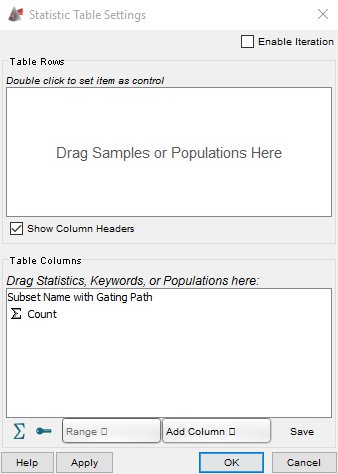
Only one tool is active at a time, and the active tool will return to the arrow after any new object is created. It contains an Arrow tool, a Rectangle tool, a Line tool, a Grid tool, a Text tool, an Ellipse tool, a Rounded Rectangle tool, a Diamond tool, a Triangle tool, a Statistics Table tool, and a Web Box tool. Tucked right above the main display window is the miniature tool palette. Below is an enlargement of the top of the layout window, showing the groups of buttons in the window. This window has a large number of controls, which are organized in groups. The Plus sign opens a new blank layout, the Blue Rectangles icon opens a copy of the current layout, the X deletes the currently visible layout. You can create new empty definitions or delete them using the buttons in the top left corner of the window. You can have as many layout definitions in the workspace as you wish.

Graphs, gates and statistics will continue to be updated in the Layout editor until your analysis is complete. Instead it is the specification of which graphs will be placed at what locations, when the layout graphic is generated. A layout definition is not the output data itself. Use the layout editor to create a new layout definition.
#Flowjo 10 layout editor manual#
The Blue Question Mark icon brings up the online FlowJo 10 layout editor Manual page. The Heart icon in the top right corner of the layout editor brings up FlowJo preferences. Once you create the interface you desire, you can save the settings to your FlowJo preferences for future layouts. This allows you to add/remove tools from the ribbon bar to create a simple yet powerful interface where you can easily access the tools you use without having to scroll through the ones you don’t. You can also personalize your tools interface by clicking the Blue Ribbon icon in the top right of the layout editor.

You can select one of five different main control tabs on the top bar to view and use a variety of tools within the layout editor. The FlowJo 10 layout editor has a Ribbon interface. It has some additional aspects as well: it supports multiple pages each with its own layout defined it has controls to apply the same layout commands to many different data files and most importantly, it has the ability to reference live data in the workspace so that graphs are updated when the underlying gating hierarchy changes.

It can draw boxes and lines, type text and move the items around with a familiar interface. In many ways, the Layout Editor is a like a simple page layout program.


 0 kommentar(er)
0 kommentar(er)
